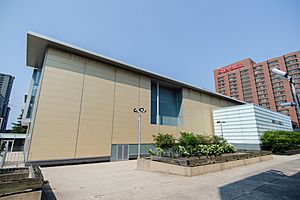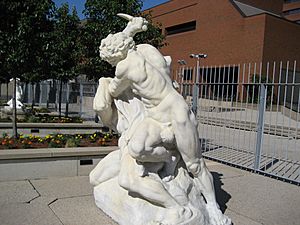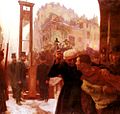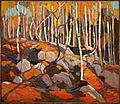Art Gallery of Hamilton facts for kids
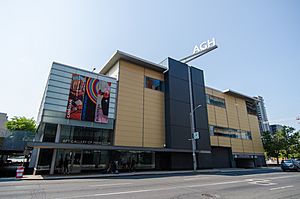
Art Gallery of Hamilton from King Street West
|
|
| Established | 31 January 1914 |
|---|---|
| Location | 123 King Street West, Hamilton, Ontario, Canada |
| Type | Art museum |
| Architect | Trevor Garwood-Jones Bruce Kuwabara (renovations) |
The Art Gallery of Hamilton (AGH) is a cool art museum located in Hamilton, Ontario, Canada. It's a big place, about 75,000 square feet, right in downtown Hamilton on King Street West. This awesome building was designed by Trevor P. Garwood-Jones. The AGH is the biggest and oldest art museum in southwestern Ontario. It's a great spot to explore art from Canada and all over the world!
Contents
A Look Back: The Gallery's Journey
The Art Gallery of Hamilton started way back in January 1914. It was first called the Municipal Gallery of Hamilton. It opened its doors to the public in June 1914. The first home for the museum was inside a Hamilton Public Library building on Main Street West.
The museum stayed at that library location until 1953. Then, it moved to a brand new building in the Westdale neighborhood. Later, in 1977, the museum moved to its current spot on King Street West. The building got a big makeover between 2003 and 2005. This renovation was designed by Bruce Kuwabara.
The idea for the museum began when the wife of artist William Blair Bruce gave many of his artworks to the City of Hamilton. She said they could have them if a good place was built to keep them safe. So, the city officially started the museum on January 31, 1914. When it first opened, it showed 33 artworks by William Blair Bruce.
In 1947, the museum got a much bigger budget. They also hired their first curator-director, Thomas Reid MacDonald. He wanted to make the art collection bigger and get a new building. A group of volunteers, called the Women’s Volunteer Committee, helped a lot. They raised money for new art and for the new building. On December 12, 1953, the museum opened a new Art Deco building in Westdale. It was right next to McMaster University.
By the 1960s, it was clear the museum needed to move again to grow. The university next door was expanding, making it hard for the museum to add more space. So, the museum decided to move downtown. This was part of a bigger city plan called the "Civic Square Project." This project also included the Hamilton Convention Centre and Hamilton Place. Trevor Garwood-Jones was chosen to design the new museum building. It opened in October 1977.
In 2003, the museum started a big renovation project that cost C$18 million. The newly updated museum building reopened in May 2005.
In 2003, the museum learned that a painting in its collection, Portrait of a Lady by Johannes Cornelisz Verspronck, might have been unfairly taken during World War II. After a 10-year investigation, the museum confirmed this in November 2014. They returned the painting to its original owners. The museum had bought the painting at an auction in 1987, not knowing its history.
From 2013 to February 2018, the museum had another small location on James Street North. It was a shop and a flexible space for museum events, like showing films. After this location closed, the museum's films are now shown at the Lincoln Alexander Centre.
The Building: A Modern Home for Art
The museum is located on King Street West in downtown Hamilton. The city owns the land, and the museum uses it through a lease. The building is 75,000 square feet and was first designed by Trevor Garwood-Jones. He was asked to design the building, and it opened in 1977. The building's original style was like other brutalist buildings in the city. It had exposed concrete and looked like strong, boxy shapes. In 1979, Garwood-Jones even won an award for his design from the Ontario Association of Architects.
Originally, the main entrance to the building was supposed to be on the second floor. It would connect to elevated walkways around Commonwealth Square. This plan, called Plus 15, was never finished. The city stopped developing these walkways. Because of this, the museum's entrance ended up being off the main streets. Commonwealth Square, next to the museum, also became disconnected from the street.
In 2003, the museum started a two-year renovation project. It was finished in 2005. KPMB Architects led the renovations, with Bruce Kuwabara as the main design partner. PCL Construction managed the building work, and Stantec managed the whole project. During the renovations, insulated gold-steel panels were added to cover the outside of the building. Most of these materials came from Dofasco. The renovations also added a pavilion and the Irving Zucker Sculpture Garden to the south of the museum. This area was once planned for the Plus 15 walkways.
Amazing Art: The Gallery's Collection
As of October 2018, the museum has more than 10,000 artworks in its permanent collection. About 12 percent of these works were created by female artists. The collection is divided into three main areas: Canadian art, contemporary art, and international art.
The Canadian collection includes art from all Canadian artists, including Indigenous Canadian artists. However, contemporary Canadian artists are part of the contemporary collection. In 2016, the museum received a gift of 75 Inuit sculptures. These were made by Inuit patients at the Hamilton Mountain Sanatorium as part of their therapy. The contemporary collection features art from all contemporary artists, no matter where they are from. The international collection includes art from non-Canadian artists. It focuses on European artists from the Baroque period to Post-Impressionism, especially French, British, and Italian art. Many works in the international collection were given by Joey and Toby Tanenbaum. This included 200 European artworks in 2002 and their entire African collection in 2010.
The museum's permanent collection started with artworks given by William Blair Bruce in 1914. From 1929 to 1947, the collection didn't grow much. This was because storage conditions weren't safe, and not many people wanted to donate art. In 1947, the museum's budget increased a lot. This allowed them to hire a curator and staff to take care of the collection.
Thomas Reid MacDonald, the museum's first curator-director, worked hard to improve the collection in the mid-20th century. The Women's Volunteer Committee also helped a lot by raising money for new art. MacDonald held an annual winter exhibition from 1948 to 1973. This gave artists a place to show their work and brought art to Hamilton that the museum could buy. Each exhibition usually had about one hundred artworks. The museum would buy one of these works for its permanent collection. This is how many important artworks were added, like A.J. Casson's First Snow, Lilias Torrance Newton's Keith MacIver, and the famous Horse and Train by Alex Colville.
Famous Artworks You Might See
One of the artworks chosen from the winter exhibition was Colville's Horse and Train. When it was first bought, an art critic from The Hamilton Spectator newspaper, Mary Mason, didn't like it much. She wrote that it wasn't one of the "very fine paintings" in the show. But this painting actually became one of the most popular artworks in the museum's collection! It has been shown on many different items in popular culture. After Colville passed away, the painting was displayed with two study drawings. These drawings showed how the artist used geometry to plan the work. The display also included a letter from Colville thanking the museum's director for buying the painting. Plus, there were books that featured the artwork.
-
Gustave Doré, The Triumph Of Christianity Over Paganism, 1868
-
James Tissot, Croquet, 1878
Learning More: The Library
The museum also has a special reference library called the Muriel Bostwick Library. This library has documents that help people learn more about the art collection. It also has old catalogs and documents from past exhibitions that the museum has put on.
See also
- Culture of Hamilton, Ontario
- List of art museums
- List of attractions in Hamilton, Ontario
- List of museums in Ontario


